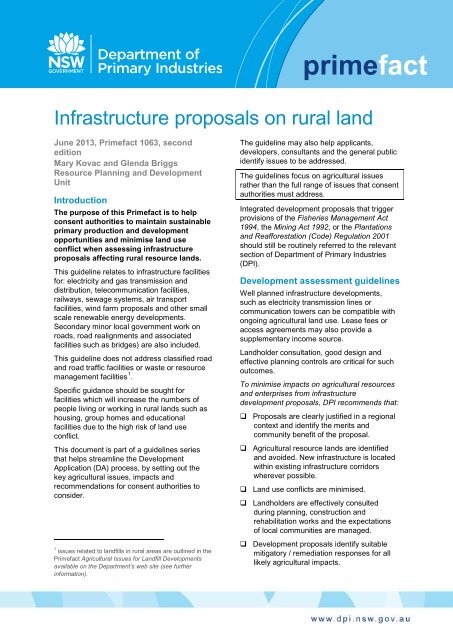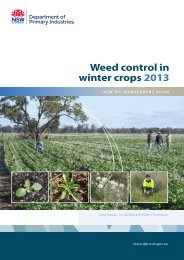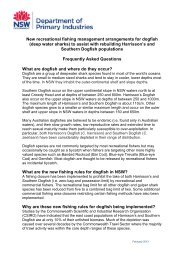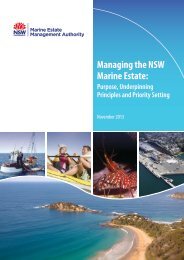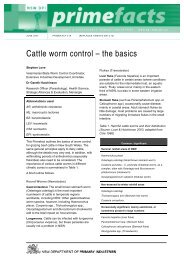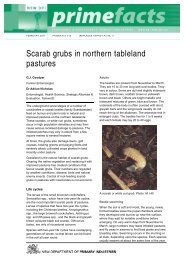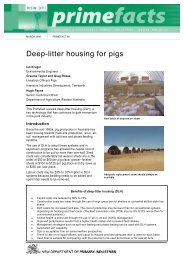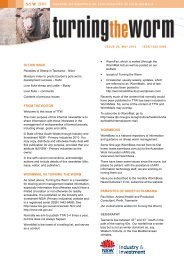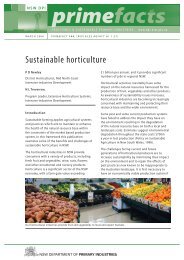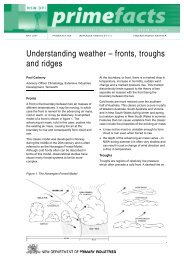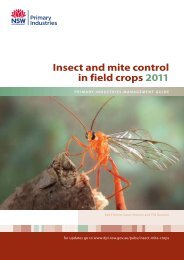Infrastructure proposals on rural land - NSW Department of Primary ...
Infrastructure proposals on rural land - NSW Department of Primary ...
Infrastructure proposals on rural land - NSW Department of Primary ...
You also want an ePaper? Increase the reach of your titles
YUMPU automatically turns print PDFs into web optimized ePapers that Google loves.
<str<strong>on</strong>g>Infrastructure</str<strong>on</strong>g> <str<strong>on</strong>g>proposals</str<strong>on</strong>g> <strong>on</strong> <strong>rural</strong> <strong>land</strong><br />
June 2013, Primefact 1063, sec<strong>on</strong>d<br />
editi<strong>on</strong><br />
Mary Kovac and Glenda Briggs<br />
Resource Planning and Development<br />
Unit<br />
Introducti<strong>on</strong><br />
The purpose <strong>of</strong> this Primefact is to help<br />
c<strong>on</strong>sent authorities to maintain sustainable<br />
primary producti<strong>on</strong> and development<br />
opportunities and minimise <strong>land</strong> use<br />
c<strong>on</strong>flict when assessing infrastructure<br />
<str<strong>on</strong>g>proposals</str<strong>on</strong>g> affecting <strong>rural</strong> resource <strong>land</strong>s.<br />
This guideline relates to infrastructure facilities<br />
for: electricity and gas transmissi<strong>on</strong> and<br />
distributi<strong>on</strong>, telecommunicati<strong>on</strong> facilities,<br />
railways, sewage systems, air transport<br />
facilities, wind farm <str<strong>on</strong>g>proposals</str<strong>on</strong>g> and other small<br />
scale renewable energy developments.<br />
Sec<strong>on</strong>dary minor local government work <strong>on</strong><br />
roads, road realignments and associated<br />
facilities such as bridges) are also included.<br />
This guideline does not address classified road<br />
and road traffic facilities or waste or resource<br />
management facilities 1 .<br />
Specific guidance should be sought for<br />
facilities which will increase the numbers <strong>of</strong><br />
people living or working in <strong>rural</strong> <strong>land</strong>s such as<br />
housing, group homes and educati<strong>on</strong>al<br />
facilities due to the high risk <strong>of</strong> <strong>land</strong> use<br />
c<strong>on</strong>flict.<br />
This document is part <strong>of</strong> a guidelines series<br />
that helps streamline the Development<br />
Applicati<strong>on</strong> (DA) process, by setting out the<br />
key agricultural issues, impacts and<br />
recommendati<strong>on</strong>s for c<strong>on</strong>sent authorities to<br />
c<strong>on</strong>sider.<br />
1 issues related to <strong>land</strong>fills in <strong>rural</strong> areas are outlined in the<br />
Primefact Agricultural Issues for Landfill Developments<br />
available <strong>on</strong> the <strong>Department</strong>’s web site (see further<br />
informati<strong>on</strong>).<br />
The guideline may also help applicants,<br />
developers, c<strong>on</strong>sultants and the general public<br />
identify issues to be addressed.<br />
The guidelines focus <strong>on</strong> agricultural issues<br />
rather than the full range <strong>of</strong> issues that c<strong>on</strong>sent<br />
authorities must address.<br />
Integrated development <str<strong>on</strong>g>proposals</str<strong>on</strong>g> that trigger<br />
provisi<strong>on</strong>s <strong>of</strong> the Fisheries Management Act<br />
1994, the Mining Act 1992, or the Plantati<strong>on</strong>s<br />
and Reafforestati<strong>on</strong> (Code) Regulati<strong>on</strong> 2001<br />
should still be routinely referred to the relevant<br />
secti<strong>on</strong> <strong>of</strong> <strong>Department</strong> <strong>of</strong> <strong>Primary</strong> Industries<br />
(DPI).<br />
Development assessment guidelines<br />
Well planned infrastructure developments,<br />
such as electricity transmissi<strong>on</strong> lines or<br />
communicati<strong>on</strong> towers can be compatible with<br />
<strong>on</strong>going agricultural <strong>land</strong> use. Lease fees or<br />
access agreements may also provide a<br />
supplementary income source.<br />
Landholder c<strong>on</strong>sultati<strong>on</strong>, good design and<br />
effective planning c<strong>on</strong>trols are critical for such<br />
outcomes.<br />
To minimise impacts <strong>on</strong> agricultural resources<br />
and enterprises from infrastructure<br />
development <str<strong>on</strong>g>proposals</str<strong>on</strong>g>, DPI recommends that:<br />
Proposals are clearly justified in a regi<strong>on</strong>al<br />
c<strong>on</strong>text and identify the merits and<br />
community benefit <strong>of</strong> the proposal.<br />
Agricultural resource <strong>land</strong>s are identified<br />
and avoided. New infrastructure is located<br />
within existing infrastructure corridors<br />
wherever possible.<br />
Land use c<strong>on</strong>flicts are minimised.<br />
Landholders are effectively c<strong>on</strong>sulted<br />
during planning, c<strong>on</strong>structi<strong>on</strong> and<br />
rehabilitati<strong>on</strong> works and the expectati<strong>on</strong>s<br />
<strong>of</strong> local communities are managed.<br />
Development <str<strong>on</strong>g>proposals</str<strong>on</strong>g> identify suitable<br />
mitigatory / remediati<strong>on</strong> resp<strong>on</strong>ses for all<br />
likely agricultural impacts.
<str<strong>on</strong>g>Infrastructure</str<strong>on</strong>g> <str<strong>on</strong>g>proposals</str<strong>on</strong>g> <strong>on</strong> <strong>rural</strong> <strong>land</strong><br />
<str<strong>on</strong>g>Infrastructure</str<strong>on</strong>g> impacts that are <strong>of</strong> particular<br />
significance for sustainable agriculture are:<br />
• Resource loss and fragmentati<strong>on</strong><br />
• Impacts <strong>on</strong> farming operati<strong>on</strong>s and<br />
livestock<br />
• Increased weed, biosecurity and bushfire<br />
risks<br />
• Site rehabilitati<strong>on</strong><br />
Recommended c<strong>on</strong>siderati<strong>on</strong>s and possible<br />
c<strong>on</strong>sent c<strong>on</strong>diti<strong>on</strong>s for the above specific<br />
issues are set out in the following secti<strong>on</strong>s.<br />
A rail loop for coal loading designed to avoid<br />
productive alluvial farm <strong>land</strong>s. Photo: D<br />
Barnes.<br />
Resource loss and fragmentati<strong>on</strong><br />
<str<strong>on</strong>g>Infrastructure</str<strong>on</strong>g> that fragments <strong>rural</strong> resource<br />
<strong>land</strong>s can permanently reduce the ec<strong>on</strong>omic<br />
and envir<strong>on</strong>mental sustainability <strong>of</strong> the farming<br />
enterprise and c<strong>on</strong>strain future development<br />
opti<strong>on</strong>s. Ideally infrastructure developments<br />
should be directed away from <strong>rural</strong> resource<br />
<strong>land</strong>s and critical farming infrastructure (eg<br />
buried irrigati<strong>on</strong> pipes, pumps, livestock yards).<br />
To minimise resource losses and impacts <strong>on</strong><br />
farm productivity c<strong>on</strong>sent authorities are<br />
advised to verify that infrastructure<br />
developments:<br />
C<strong>on</strong>sider agricultural <strong>land</strong> use and holding<br />
patterns in the locality, existing<br />
infrastructure and primary industry<br />
resources.<br />
Identifies important agricultural resources<br />
and farm infrastructure, including surface<br />
and groundwater resources <strong>on</strong> which<br />
agriculture depends.<br />
Minimises the footprint <strong>of</strong> proposed works<br />
and easements.<br />
Minimises further resource fragmentati<strong>on</strong><br />
and does not create lots smaller than the<br />
current minimum lot size for that z<strong>on</strong>e.<br />
Where possible facilitates the c<strong>on</strong>solidati<strong>on</strong><br />
<strong>of</strong> existing lots and any isolated farm<br />
<strong>land</strong>s.<br />
Co-locates infrastructure within existing<br />
corridors (e.g. road or rail reserves or<br />
existing easements) where ever possible.<br />
Buries pipelines and cables where feasible,<br />
subject to appropriate <strong>land</strong> rehabilitati<strong>on</strong><br />
c<strong>on</strong>siderati<strong>on</strong>s.<br />
Impacts <strong>on</strong> farming operati<strong>on</strong>s and<br />
livestock<br />
<str<strong>on</strong>g>Infrastructure</str<strong>on</strong>g> <str<strong>on</strong>g>proposals</str<strong>on</strong>g> can result in<br />
interrupti<strong>on</strong>s to internal or external farm access<br />
and to farm services that may affect the<br />
efficient operati<strong>on</strong> and sustainability <strong>of</strong><br />
agricultural businesses.<br />
Farm businesses rely <strong>on</strong> access to road<br />
networks for supplies, employees, specialist<br />
support services and selling products. Access<br />
to infrastructure such as power,<br />
communicati<strong>on</strong> and water can also be critical<br />
for animal welfare and business survival.<br />
Reliable, effective access to the road network<br />
and services is particularly critical at peak<br />
selling or harvesting times and for intensive<br />
livestock operati<strong>on</strong>s (eg dairies, poultry),<br />
horticultural and vegetable enterprises.<br />
Internal access to water, pastures, feed<br />
storage and farm infrastructure (eg irrigati<strong>on</strong><br />
equipment) can also be vital for animal welfare<br />
and sustainable farming. Operating farms <strong>of</strong>ten<br />
comprise more than <strong>on</strong>e allotment and need to<br />
access resources, livestock and crops spread<br />
across the holding.<br />
Facilities such as proposed overhead<br />
electricity lines may also create c<strong>on</strong>cerns<br />
about air safety for agricultural operati<strong>on</strong>s such<br />
as crop spraying or the safe movement <strong>of</strong><br />
agricultural machinery movement where<br />
ground clearance may be limited.<br />
<str<strong>on</strong>g>Infrastructure</str<strong>on</strong>g> <str<strong>on</strong>g>proposals</str<strong>on</strong>g> should:<br />
Assess potential impacts <strong>on</strong> the safe use<br />
<strong>of</strong> farm machinery and routine farm<br />
activities.<br />
Assess the potential impacts <strong>on</strong> the ability<br />
to undertake aerial agricultural activities<br />
such as the aerial applicati<strong>on</strong> <strong>of</strong> seed,<br />
fertilisers or chemicals. Surrounding <strong>land</strong><br />
owners may also be impacted.<br />
2 <strong>NSW</strong> <strong>Department</strong> <strong>of</strong> <strong>Primary</strong> Industries, June 2013
<str<strong>on</strong>g>Infrastructure</str<strong>on</strong>g> <str<strong>on</strong>g>proposals</str<strong>on</strong>g> <strong>on</strong> <strong>rural</strong> <strong>land</strong><br />
Avoid, or promptly mitigate significant<br />
changes to access to the road network,<br />
internal farm tracks and critical farm<br />
infrastructure (eg buried irrigati<strong>on</strong> systems<br />
or ph<strong>on</strong>e lines).<br />
Locate infrastructure developments in<br />
c<strong>on</strong>sultati<strong>on</strong> with <strong>land</strong>holders. Siting<br />
facilities parallel to or immediately<br />
adjoining to existing farm infrastructure<br />
(e.g. fence lines or irrigati<strong>on</strong> lines) is<br />
usually preferred.<br />
Plan the timing <strong>of</strong> c<strong>on</strong>structi<strong>on</strong> operati<strong>on</strong>s<br />
and the locati<strong>on</strong> / design <strong>of</strong> temporary<br />
fencing and temporary access routes to<br />
minimise impacts <strong>on</strong> farm operati<strong>on</strong>s and<br />
livestock.<br />
Where the proposal will divide existing<br />
farm operati<strong>on</strong>s or properties the proposal<br />
should include measures to ensure<br />
<strong>on</strong>going access between each secti<strong>on</strong>.<br />
Access must be <strong>of</strong> an appropriate design<br />
standard to support <strong>on</strong>going agricultural<br />
use and should be developed in<br />
c<strong>on</strong>sultati<strong>on</strong> with the <strong>land</strong>holder.<br />
Develop site access protocols that lists the<br />
relevant <strong>land</strong>holder c<strong>on</strong>tact details and<br />
includes measures to minimise adverse<br />
impacts such as:<br />
• Leaving gates open or shut as found.<br />
• Driving carefully to minimise disturbance to<br />
livestock, crops and pastures, and<br />
• Minimising disturbance to the envir<strong>on</strong>ment<br />
e.g. <strong>land</strong> clearing.<br />
Increased biosecurity, pest and<br />
weed risks and impacts <strong>on</strong> livestock<br />
Biosecurity for agriculture, including genetically<br />
modified crops, relies <strong>on</strong> limiting vehicle and<br />
people movements <strong>on</strong> <strong>rural</strong> properties and<br />
being able to trace vehicle, people and stock<br />
movements if any disease outbreaks arise.<br />
<str<strong>on</strong>g>Infrastructure</str<strong>on</strong>g> developments typically result in<br />
temporary, but significant increases in vehicle<br />
movements <strong>on</strong> and <strong>of</strong>f <strong>rural</strong> properties. This<br />
risk is increased if new access points are<br />
created and if machinery moves across<br />
multiple <strong>rural</strong> properties.<br />
Pest animals may also be encouraged by food<br />
sources from c<strong>on</strong>structi<strong>on</strong> works and new<br />
access tracks. The additi<strong>on</strong>al vehicle<br />
movements and development activities may<br />
also increase the risk <strong>of</strong> bushfires.<br />
C<strong>on</strong>structi<strong>on</strong> activities may also increase the<br />
risk <strong>of</strong> straying livestock, especially if gates are<br />
left open or if fences need to be cut or<br />
replaced.<br />
Livestock can also be panicked or stressed by<br />
rapid vehicle movements or sudden noises<br />
which may result in injury or escape.<br />
C<strong>on</strong>sent authorities are advised to verify that<br />
development <str<strong>on</strong>g>proposals</str<strong>on</strong>g> appropriately identify:<br />
Potential biosecurity risks such any<br />
increased vehicle movement <strong>on</strong>to and <strong>of</strong>f<br />
farms that could spread animal or plant<br />
material or diseases. This is particularly<br />
critical if genetically modified (GM) crops<br />
or organic crops occur within or adjoining<br />
the proposed development route.<br />
Significant weed species within the<br />
proposed development footprint and risks<br />
<strong>of</strong> spread.<br />
The locati<strong>on</strong>, status and management <strong>of</strong><br />
current and former livestock dip sites and<br />
other potentially c<strong>on</strong>taminated sites within<br />
the infrastructure corridor or area.<br />
Bushfire or other emergency management<br />
risks.<br />
Impacts <strong>on</strong> livestock including the polluti<strong>on</strong><br />
<strong>of</strong> waterways and noise risks that may<br />
result in injury or escape.<br />
Where infrastructure <str<strong>on</strong>g>proposals</str<strong>on</strong>g> transect more<br />
than <strong>on</strong>e property DPI recommends that<br />
c<strong>on</strong>sent c<strong>on</strong>diti<strong>on</strong>s require the development <strong>of</strong><br />
a Weed management plan in c<strong>on</strong>sultati<strong>on</strong> with<br />
relevant Weed Authorities.<br />
A Weed Management Plan should identify:<br />
Notifiable and problematic envir<strong>on</strong>mental<br />
weeds that could affect farm productivity.<br />
The additi<strong>on</strong>al risks resulting from the<br />
proposed development and their<br />
assessment. Advice is available from the<br />
local council weeds <strong>of</strong>ficer or <strong>on</strong> the<br />
website listed at the end <strong>of</strong> this guideline.<br />
State, regi<strong>on</strong>al or local plan or strategies<br />
for relevant to specific weeds that occur <strong>on</strong><br />
the property area or that may be<br />
transported to the proposed works from<br />
surrounding areas.<br />
Weed suppressi<strong>on</strong>, management and<br />
c<strong>on</strong>tainment strategies for all disturbed<br />
areas. For instance soil stockpiles,<br />
roadsides leading to the <strong>land</strong>fill site and<br />
disturbed areas.<br />
Measures to limit the spread <strong>of</strong> existing<br />
weeds include cleaning vehicle tyres<br />
before moving from property to property,<br />
3 <strong>NSW</strong> <strong>Department</strong> <strong>of</strong> <strong>Primary</strong> Industries, June 2013
<str<strong>on</strong>g>Infrastructure</str<strong>on</strong>g> <str<strong>on</strong>g>proposals</str<strong>on</strong>g> <strong>on</strong> <strong>rural</strong> <strong>land</strong><br />
footwear checks, minimising and<br />
m<strong>on</strong>itoring soil movement between<br />
properties.<br />
M<strong>on</strong>itoring programs for noxious and<br />
problematic weeds <strong>on</strong> site and in the<br />
surrounding areas and proposed follow up<br />
c<strong>on</strong>trols if weed problems occur.<br />
I&I <strong>NSW</strong> also recommends that c<strong>on</strong>sent<br />
authorities require infrastructure prop<strong>on</strong>ents <strong>on</strong><br />
<strong>rural</strong> <strong>land</strong>s to develop protocols to:<br />
Ensure effective c<strong>on</strong>sultati<strong>on</strong> with<br />
<strong>land</strong>holders regarding the timing <strong>of</strong><br />
operati<strong>on</strong>s, site access needs and any<br />
special measures to minimise impacts <strong>on</strong><br />
livestock and crops. For instance the<br />
project design should seek to avoid or<br />
minimising the need to cut farm fences or<br />
traverse crops.<br />
Manage vehicle movements <strong>on</strong>to and<br />
across farms. This might include<br />
separating work sites from farm areas,<br />
restricting the number <strong>of</strong> vehicles<br />
accessing farm properties and m<strong>on</strong>itoring<br />
vehicle movements <strong>on</strong> farms.<br />
Avoid biosecurity risks and ensure<br />
appropriate dec<strong>on</strong>taminati<strong>on</strong> <strong>of</strong> vehicles<br />
moving between properties if necessary.<br />
Manage wastes and polluti<strong>on</strong> risks.<br />
Manage, mitigate and m<strong>on</strong>itor emergency<br />
risks as part <strong>of</strong> emergency management<br />
planning for the proposed development.<br />
Well rehabilitated <strong>rural</strong> road bridge at Kyw<strong>on</strong>g.<br />
Photo: M Dingham.<br />
Site rehabilitati<strong>on</strong><br />
Rehabilitati<strong>on</strong> is important to prevent erosi<strong>on</strong><br />
and the sedimentati<strong>on</strong> <strong>of</strong> waterway or dams,<br />
limit weed germinati<strong>on</strong> and restore productive<br />
<strong>land</strong> use opti<strong>on</strong>s.<br />
C<strong>on</strong>sent authorities are advised to ensure that<br />
prop<strong>on</strong>ents:<br />
Develop appropriate rehabilitati<strong>on</strong><br />
objectives and strategies in c<strong>on</strong>sultati<strong>on</strong><br />
with <strong>land</strong>holders and relevant agencies (eg<br />
the local government weed authorities and<br />
catchment management authorities).<br />
DPI additi<strong>on</strong>ally recommends that prop<strong>on</strong>ents<br />
are required to develop a comprehensive<br />
Envir<strong>on</strong>mental Management Plan that<br />
documents:<br />
Envir<strong>on</strong>mental policies, rehabilitati<strong>on</strong><br />
objectives and strategies.<br />
Specific measures to protect catchment<br />
values and productive capacity including<br />
soil and erosi<strong>on</strong> mitigati<strong>on</strong> <str<strong>on</strong>g>proposals</str<strong>on</strong>g>.<br />
Any residual (i.e. permanent) impacts <strong>on</strong><br />
agricultural or other primary industries.<br />
Project staging and the timeframes for site<br />
rehabilitati<strong>on</strong>. Progressive site<br />
rehabilitati<strong>on</strong> is encouraged.<br />
Topsoil management <str<strong>on</strong>g>proposals</str<strong>on</strong>g> to make<br />
best use <strong>of</strong> this resource and maximise<br />
rehabilitati<strong>on</strong> and revegetati<strong>on</strong> success.<br />
Recommended practices include:<br />
• the removal <strong>of</strong> topsoil before disturbing<br />
sub-soils or erecting permanent<br />
structures.<br />
• The immediate reuse <strong>of</strong> topsoil. If this<br />
is not feasible, topsoils should be<br />
temporarily stored in accord with best<br />
practices.<br />
Critical Best Practice acti<strong>on</strong>s focus <strong>on</strong><br />
maintaining soil health and the vigour <strong>of</strong><br />
native seed, limiting weed germinati<strong>on</strong>,<br />
and avoiding soil loss and catchment<br />
impacts.<br />
Proposals to reform the <strong>land</strong>scape to blend<br />
with surrounding <strong>land</strong>forms and avoid <strong>land</strong><br />
use c<strong>on</strong>flicts.<br />
Vegetati<strong>on</strong> re-establishment strategies and<br />
acti<strong>on</strong>s. Recommended practices include:<br />
• De-compacti<strong>on</strong> <strong>of</strong> areas traversed by<br />
heavy machinery to encourage plant<br />
growth and minimise run <strong>of</strong>f.<br />
4 <strong>NSW</strong> <strong>Department</strong> <strong>of</strong> <strong>Primary</strong> Industries, June 2013
<str<strong>on</strong>g>Infrastructure</str<strong>on</strong>g> <str<strong>on</strong>g>proposals</str<strong>on</strong>g> <strong>on</strong> <strong>rural</strong> <strong>land</strong><br />
• C<strong>on</strong>siderati<strong>on</strong> <strong>of</strong> seas<strong>on</strong>al c<strong>on</strong>diti<strong>on</strong>s<br />
and timing revegetati<strong>on</strong> efforts to<br />
maximise success.<br />
• Sowing <strong>of</strong> cover crops or pastures to<br />
stabilise disturbed sites and reduce<br />
weed growth.<br />
• Using species suitable for the<br />
proposed end use and locality. A<br />
particular priority should be the use <strong>of</strong><br />
clean seed and species with a low risk<br />
<strong>of</strong> c<strong>on</strong>tributing to weed problems.<br />
• Rehabilitating unwanted tracks to<br />
reduce pest animal problems.<br />
• Allowing for soil settling and provisi<strong>on</strong>s<br />
to refill disturbed sites.<br />
M<strong>on</strong>itoring <str<strong>on</strong>g>proposals</str<strong>on</strong>g> to asses the<br />
effectiveness <strong>of</strong> rehabilitati<strong>on</strong> efforts and<br />
repair as required.<br />
The resp<strong>on</strong>sible pers<strong>on</strong> and organisati<strong>on</strong><br />
for site management and remediati<strong>on</strong><br />
during and post c<strong>on</strong>structi<strong>on</strong>.<br />
Additi<strong>on</strong>al issues<br />
DPI recommends that c<strong>on</strong>sent authorities<br />
ensure that prop<strong>on</strong>ents:<br />
C<strong>on</strong>sult with relevant agencies such as the<br />
local government weed authorities and<br />
catchment management authorities <strong>on</strong> the<br />
design, c<strong>on</strong>structi<strong>on</strong> and operati<strong>on</strong> <strong>of</strong> the<br />
proposed infrastructure.<br />
C<strong>on</strong>sult with the owners and managers <strong>of</strong><br />
affected and adjoining agricultural<br />
operati<strong>on</strong>s in a timely and appropriate<br />
manner about the proposal, the likely<br />
impacts and suitable mitigati<strong>on</strong> measures<br />
or compensati<strong>on</strong>.<br />
Provide sufficient documentati<strong>on</strong> to<br />
dem<strong>on</strong>strate that all significant impacts <strong>on</strong><br />
current and future agricultural<br />
developments and resources have been<br />
identified and can be reas<strong>on</strong>ably avoided<br />
or adequately mitigated.<br />
Minimise <strong>land</strong> use c<strong>on</strong>flict. The publicati<strong>on</strong><br />
‘Living and Working in Rural Areas: A<br />
handbook for managing <strong>land</strong> use c<strong>on</strong>flict<br />
issues <strong>on</strong> the <strong>NSW</strong> North Coast’ outlines<br />
c<strong>on</strong>flict issues and suggesti<strong>on</strong>s <strong>on</strong> dealing<br />
with <strong>land</strong> use c<strong>on</strong>flict. It also provides a<br />
guide for c<strong>on</strong>flict risk assessment and<br />
mitigati<strong>on</strong> that may be useful.<br />
Strategic planning for infrastructure<br />
in agricultural areas<br />
Councils are encouraged to strategically<br />
review desired planning outcomes for <strong>rural</strong><br />
<strong>land</strong>s; and identify important resources and<br />
sustainable development opportunities for<br />
agricultural enterprises.<br />
Strategic studies should identify infrastructure<br />
needs and preferred infrastructure corridors or<br />
locati<strong>on</strong>s to minimise the risk <strong>of</strong> <strong>land</strong> use<br />
c<strong>on</strong>flict.<br />
Further informati<strong>on</strong><br />
<strong>NSW</strong> DPI has additi<strong>on</strong>al web based<br />
informati<strong>on</strong> and publicati<strong>on</strong>s <strong>on</strong> pasture and<br />
weed management and minimising c<strong>on</strong>flict<br />
risks with adjoining agricultural <strong>land</strong> uses.<br />
This includes informati<strong>on</strong> <strong>on</strong>:<br />
• Weeds<br />
• Land Use C<strong>on</strong>flict Risk Assessment (Living<br />
and Working in Rural Areas)<br />
• Agricultural Issues for Landfill<br />
Developments - a guideline for Assessing<br />
agricultural impacts related to Waste<br />
Management (<strong>land</strong>fill) facilities in <strong>rural</strong><br />
areas.<br />
Additi<strong>on</strong>al informati<strong>on</strong> <strong>on</strong> animal diseases and<br />
pests can be sourced from local Livestock Pest<br />
and Health Authorities.<br />
Other informati<strong>on</strong> in relati<strong>on</strong> to these<br />
developments are available at the register for<br />
development guidelines.<br />
Some relevant guidelines found at this site<br />
include:<br />
<strong>Department</strong> <strong>of</strong> Water and Energy 2008<br />
Guidelines for c<strong>on</strong>trolled activities: Instream<br />
Works and Guidelines for c<strong>on</strong>trolled activities:<br />
Laying pipes and cables in water courses.<br />
<strong>Department</strong> <strong>of</strong> <str<strong>on</strong>g>Infrastructure</str<strong>on</strong>g>, Planning and<br />
Natural Resources 2004 Guideline for the<br />
Preparati<strong>on</strong> <strong>of</strong> Envir<strong>on</strong>mental Management<br />
Plans.<br />
State <strong>of</strong> <strong>NSW</strong> and <strong>Department</strong> <strong>of</strong> Envir<strong>on</strong>ment<br />
and Climate Change 2009 Interim C<strong>on</strong>structi<strong>on</strong><br />
Noise Guide.<br />
<strong>NSW</strong> Rural Fire Service 2006 Planning for<br />
Bushfire Protecti<strong>on</strong>.<br />
5 <strong>NSW</strong> <strong>Department</strong> <strong>of</strong> <strong>Primary</strong> Industries, June 2013
<str<strong>on</strong>g>Infrastructure</str<strong>on</strong>g> <str<strong>on</strong>g>proposals</str<strong>on</strong>g> <strong>on</strong> <strong>rural</strong> <strong>land</strong><br />
Acknowledgements<br />
The authors would like to acknowledge the<br />
following people for their c<strong>on</strong>tributi<strong>on</strong> to this<br />
Primefact:<br />
Andrew Docking, Rik Whitehead, Wendy<br />
Goodburn, DPI, and Mark Parker, <strong>NSW</strong><br />
<strong>Department</strong> <strong>of</strong> Planning and <str<strong>on</strong>g>Infrastructure</str<strong>on</strong>g>.<br />
© State <strong>of</strong> New South Wales through the <strong>Department</strong> <strong>of</strong> Trade and<br />
Investment, Regi<strong>on</strong>al <str<strong>on</strong>g>Infrastructure</str<strong>on</strong>g> and Services 2013. You may<br />
copy, distribute and otherwise freely deal with this publicati<strong>on</strong> for<br />
any purpose, provided that you attribute the <strong>NSW</strong> <strong>Department</strong> <strong>of</strong><br />
<strong>Primary</strong> Industries as the owner.<br />
Disclaimer: The informati<strong>on</strong> c<strong>on</strong>tained in this publicati<strong>on</strong> is based<br />
<strong>on</strong> knowledge and understanding at the time <strong>of</strong> writing (June 2013).<br />
However, because <strong>of</strong> advances in knowledge, users are reminded<br />
<strong>of</strong> the need to ensure that informati<strong>on</strong> up<strong>on</strong> which they rely is up to<br />
date and to check currency <strong>of</strong> the informati<strong>on</strong> with the appropriate<br />
<strong>of</strong>ficer <strong>of</strong> the <strong>Department</strong> <strong>of</strong> <strong>Primary</strong> Industries or the user’s<br />
independent adviser.<br />
Published by the <strong>NSW</strong> <strong>Department</strong> <strong>of</strong> <strong>Primary</strong> Industries.<br />
ISSN 1832-6668<br />
Check for updates <strong>of</strong> this Primefact at:<br />
www.dpi.nsw.gov.au/factsheets<br />
Job number 10346 PUB 13/68<br />
6 <strong>NSW</strong> <strong>Department</strong> <strong>of</strong> <strong>Primary</strong> Industries, June 2013


